Introduction
In Canada, as in other Western countries, much media and scholarly attention surrounding the “War on Terror” has focused on cases in which primarily Muslim citizens have been detained and charged under the anti-terror law passed hastily in 2001. However, little analysis has been conducted on how changes to laws and communicative strategies on terror have re-framed the domestic neo-liberal agenda, and, in so doing, fostered a militarized culture of surveillance and fear of the enemy inside national borders, ultimately extending war as an infinite domain and reconfiguring the political economy of state communication. Recent domestic attacks in 2014 on Canadian soil have served to both vindicate and intensify the government’s focus on domestic terror, both discursively and in further legislation.
This paper specifically examines the Canadian government’s domestic politics of terror through its communication on the inter-related issues of crime, defence, security, and immigration that are propagated through the lens of the global War on Terror. Using parliamentary records, public documents, and media stories, the paper suggests that, over time since it came to power in 2006, the government has invoked both the Muslim Other and a subtler, more generalized domestic public enemy in order to capitalize on public concern and fear of terrorism to justify its neo-liberal legislative agenda and consolidate its power within the broader neo-liberal project (Cottle, 2009).
The paper focuses particularly on the period leading up to the re-election of the Conservatives in 2011 and the shift from a minority to majority government. In that 2010-2011 period of time, the government stepped up its law-and-order agenda, using discursive strategies that stressed security, policing, and the military, such as public protection (specifically of our borders), public safety against crime and violence, the rights of victims, and security threats from terrorism and illegal immigration, in both its internal and international communication messages and legislation. Its emphasis on domestic security issues reinforced the threat of terrorism beyond our borders and support for our military participation in Afghanistan, as well as the continued insecurity of terrorism beyond our borders that amplified the possibilities of domestic terrorism. In ramping up communication and legislation activity to reach the tipping point of the 2011 election, the government was utilizing Gramsci’s war of position that builds decisively in different sectors on different political levels to achieve its goal of a majority mandate (Kozolanka, 2007: 18). This global-to-national approach was a ground war as much as it was fought in Parliament, communicating so pervasively that, even in a minority mandate, the government managed to pass legislation unprecedented in depth and breadth. Using its legislative activity as a cornerstone and strengthened by communication strategies, its strategy to embed its militarized worldview into the fabric of Canadian life has continued.
Fostering the Militarized State
Prior to the events of 9/11, militarization in Western societies was focused on rogue governments beyond their borders as a way of policing them (Hardt & Negri, cited in McCready, 2010). However, the seeds of militarization of Western societies began with the late 20th century shift away from the welfare state and “the strengthening and consolidation of the ‘warfare’ or ‘security’ state” (Harvey in McCready, 2010: 30). As D. Schiller articulates, this new “authoritarian development” moved neo-liberalism into a “public-private fusion of power” (2004: 171) that used the state rather than rejecting it, as it was needed to pass legislation focused on anti-terror mechanisms and other issues related to security and law and order. This coalescing militarized culture is now “intrinsic to the state’s mode of economic, political, and cultural (re)production” (Sussman, 2011: 2) in a society where culture and cultural identity define us. Militarized culture has seeped into everyday life precisely because it has been communicated endlessly. Moreover, militarized culture needs a global war on terror that is “unlimited and unending, and requires little justification—the perfect ideological and coercive instrument for managing neoliberal global capitalism” (Artz, 2011: 214). Some of these successes emanating from the resultant “boundless ideological meanings” (216) have been used in the opportunistic communication strategies of the Canadian government of Stephen Harper since 2006, but specifically as his hegemonic project coalesced in the 2010-2011 period.
It is also enlightening to remember that the history of public relations shows how war and conflict propelled the development of the public relations industry (Miller in Bernays, 2004) and its use by governments, from wartime propaganda to political marketing. In addition, technology in the form of the Internet—now in widespread use for communication—was first developed by and for military and security purposes. Currently and specifically to Canada, Mazepa’s analysis suggests that the Canadian government is run on military priorities, and its foreign policy has, in effect, become its domestic policy, and is communicated using military discourses. It accomplishes this by “bringing together military and non-military actors (government departments, civilian organizations, and private corporations) to resolve situations of conflict and crisis, nationally and internationally” (Mazepa, 2011: 305). In so doing, it also furthers and extends the reach of the neo-liberal state through its coordinated ideology, methodology and propaganda (Ibid: 308).
When the state’s public relations become the engine to propel a political agenda, militarized or otherwise, it becomes what I have elsewhere called a “publicity state”, in which “a permanent campaign requires permanent persuasion to maintain popular support “ (Kozolanka, 2014a: 19). Along with neo-liberalism’s renewed use of the state to achieve its ends, the concomitant rise and envelopment by the state of publicity affirms and extends H. Schiller’s (1992) concept of the military-industrial communication complex.
Canada’s history, as former dependent commonwealth member, has echoed British foreign policy and its militarism; as a fledgling nation, it is often said that the country only came of age in and through WWI. However, Canada has also been influenced by the global policy of its nearest neighbour, the United States. In the case of the 9/11 attacks, Canada followed the lead of the United States, echoing the latter’s Patriot Act in its own hastily passed Anti-Terrorism Act, even before the United Kingdom did the same. More recently, the Harper government opportunistically used the rise of ISIL (The Islamic State of Iraq and the Levant) and specifically the attack on the Parliament Buildings in 2014 to extend anti-terror measures in a new law in late 2014(C-44: The Protection of Canada from Terrorists Act) and a further one in early 2015 (C-51: An Act to enact the Security of Canada Information Sharing Act and the Secure Air Travel Act, to amend the Criminal Code, the Canadian Security Intelligence Service Act and the Immigration and Refugee Protection Act and to make related and consequential amendments to other Acts), informally known as the anti-terror act.
A key element in the government’s legislative agenda and communicative strategies on terror and the response to terror relates to conservatism itself. The post-war Western consensus and Keynesian economics were based on redistribution and equality that placed boundaries on unfettered capitalism. Beginning in the 1980s, and after a long and oddly (for conservatives) Gramscian strategy, conservatism began its resurgence. The election of Margaret Thatcher in the United Kingdom, Ronald Reagan in the United States, and David Lange in New Zealand, followed by provincial governments in Canada, notably Alberta and Ontario, signaled an attack on the post-WW2 welfare state (Kozolanka, 2007). The post-9/11 era can be seen as a second wave of neo-conservatism (now more commonly called neo-liberalism) that relies on what can only be called fear and greed. Fox Piven has warned that “war overseas always has a home front—and domestic fallout” (2004: 1). In the United States, the “emotional fervor generated by these wars smoothed the way for huge advances in the domestic neo-conservative agenda” (Piven, 2004: 2). Advances in capitalism occur more rapidly during wartime as machinery ramps up. The fall-out from the war on terror includes curtailing social programs and the civil liberties of citizens, while simultaneously grossly inflating defence budgets—in Canada, by 54% between 9/11 and 2011 (Robinson 2011)—and commonly contracting the work out to private companies. Beyond the gains of capitalism, such a culture also embeds militarism into everyday practices and life (Giroux in McCready, 2010: 33). This, Harper has done incessantly, conflating democracy and rule of law with a stronger military capability and presence (Staples, 2008: 245).
The mass media are a key component in amplifying the state’s messages on terror. Breaking events and 24-hour news require constant vigilance to be first with the news, which then enables the famous “first draft of history” to become also the draft that might be provided by the public relations staff of the government of the time. The limitations in today’s media systems and practice are many and reinforce news as a commodity that needs to be sold, while media concentration and conglomeration use the balance sheet as a bottom line, cutbacks specifically target editorial rooms, and the shift to online media makes news immediate and available (Nacos, Bloch-Elkon & Shapiro, 2011). These conditions provide openings for discourses of risk and terror to proliferate and become engrained in the public psyche.1
Cottle (2009) makes the distinction between mediation and mediatization of the coverage of wars, wherein mediation communicates events of war to the public, while mediatization shapes and conducts the course of events. In the latter, war is “conducted in and through the news media as well as being communicated by it” (Cottle, 2009: 110, emphasis in original). For instance, Donald Rumsfeld’s “shock and awe” in the first Gulf war is not just reporting the facts, but instead engages the media (and the public) in the spectacle. Moreover, in visualized news, the screen itself becomes a key actor that “amplifies terrorist threats” and becomes “an actual constituent of terrorism” (Hoskins & O’Loughlan in Cottle, 2009: 188-189). Yet, the endlessly repeated events also “diminish their shock value” (Cottle, 2009: 123), by “moving precariously and disturbingly between amplification and containment” (Hoskins & O’Loughlan in Cottle, 2009: 123). This was a key element in the legislative and communication strategies of the Harper government.
The research of Nacos and colleagues (2011) on the post-9/11 period under the Bush administration reveals how a government can sell fear to citizens and condition them to support military responses to terrorist acts. A “climate of fear” was created through frequent alerts of terrorist threats that were amplified by the media, while the president and other elite officials “framed and dominated” the coverage (Nacos et al., 2011: 122). Dissenting voices were buried by the one-sided media and did not reach the public. By the time of the invasion of Iraq in early 2003, “siding with the terrorists was intimidating enough to keep the media watchdog muzzled” (Ibid: 124). In effect, “the mainstream media became for the most part a propaganda arm of government” (Ibid). As this analysis will show, the fear of being considered on the side of the terrorists—a de facto “othering” of citizens not on-side—was a strong underlying aspect of the Canadian government’s messages to Canadians. This extends Karim’s (2000: 11) analysis whereby Western powers deemed Islam the “post-Cold War Other”, an external enemy, to a deliberatively provocative use of the concept to suggest that those who opposed the government’s march to war during the time-frame in this paper were Canada’s domestic enemies.
Since 2001, mediatization has kept audiences watching endlessly the spectacle of bloodless and painless war. Yet, while the spectacle in 2014 and 2015 of close-up individual deaths through ISIS’s one-at-a-time beheadings sickens screen-watching audiences, the public response is for retaliation, that is, for more spectacle. And the fear of spectacle, as Compton has noted, is “a global commodity” that, when connected to the spectacle and repetition of 9/11 has “all too often been used to hypostatize terror” (2010: 349). In addition, the fear and anger that is magnified through spectacle enables governments on both sides of a conflict to react harshly and demonize the enemy further (Nacos et al., 2011: 34). In effect, the state and its enemies share similar communication strategies.
While the Harper government was not in power at the time of the events of 9/11, it inherited and expanded greatly on both discourses and legislative measures that mutually supported each other in constructing both the global enemy and, in the present analysis, its later and more pernicious domestic enemy.
Constructing the Global Enemy
Legislation as Communication
While the mediatized coverage of terror in the global environment has been examined by many (e.g., Freedman & Thussu, 2012; Nacos et al., 2011), beyond the initial laws enacted by Western countries immediately after the events of 9/11, little analysis has focused specifically on sustained use of legislation and the communication of such legislation in reinforcing the global and domestic enemy.
The present analysis of the subject matter of legislation introduced by Canadian governments before and after 9/11 was very revealing (see Figure 1). The four interwoven subjects of crime, defence, security, and immigration were selected to follow through different time-frames and governments because the descriptions of the bills put forward in each Parliamentary session reflected the policy areas that those governments prioritized in a post-9/11 environment.
Figure 1: Domestic Legislation echoes Global Security Themes
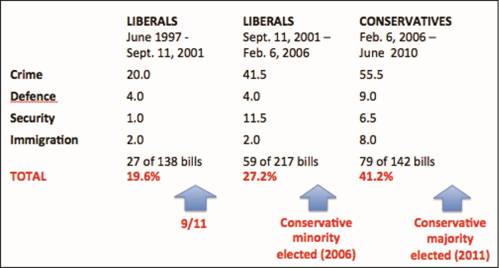
Many of the bills were not passed into law, however, they were often reintroduced in each session of Parliament until eventually enacted or until they died at the end of a Parliament. In this analysis, all bills were counted in each session, so many of them recurred in the analysis more than once. The rationale for counting bills more than once is that they emphasized the ongoing importance of these four key interlocking themes to the government and its determination to pass into law those bills that reflected their highest priorities. In legislation that contained more than one of these four areas, which occurred rarely, each of the two subjects was counted as one-half.
The many re-introductions of bills were also part of the process of working within a minority government that must broker and foster alliances to pass the bills through the lengthy legislative process. This includes three readings within the House of Commons, as well as discussion at the appropriate all-party Parliamentary committees for each reading. The committees, comprised proportionally of members from officially recognized political parties represented in Parliament, bring in experts suggested and agreed upon by the committee members.
One aspect of the legislative agenda of the Harper government was the use of bill titles to give a strong political message to communicate to Canadians (and for posterity). The bill-title-as-political-message first emerged from the Ontario government under Mike Harris in 1995. Where previously a bill that updated or made changes related to crime might be given a generic title such as Bill to Amend the Criminal Code now it was Standing Up for Victims of White Collar Crime. Other bill titles included: Cracking Down on Crooked Consultants Act, Truth in Sentencing Act, and Serious Time for the Most Serious Crime Act. The message on crime, used as a wedge issue, was also fortified through a government website. Normally, each department has its own self-named website, however, the political campaign against crime had its own special website that was called simply “Tackling Crime” (see Figure 2).
In addition, government backbenchers can and did table “record numbers” of private members’ bills with the government taking the unusual step of endorsing and passing three of them (Cheadle, 2013, May 9: 6). These bills, which bypass the regular Parliamentary legislative process, are related to and assist the government’s crime agenda, but they also send a message to constituents that the government is fulfilling its promise to be tough on crime.
Figure 2: Global security becomes linked to Domestic Crime

In addition, the government has relied on omnibus bills to push through its political agenda quickly and avoid scrutiny by the opposition and the media, in effect abrogating the democratic process that requires communication, dialogue, and debate. Prior to New Right governments, omnibus bills were used to tidy up previous legislation or make small changes, with one such bill following the annual budget. In contrast, the Harper government has used these huge omnibus bills regularly as a strategy to minimize possibilities for the political opposition to communicate and gather support on the many controversial issues they contain (Kozolanka, 2007). Between May 2012 and October 2014 alone, the Harper government enacted an unprecedented six such bills.2 Compounding the lack of scrutiny of the content of such bills, these bills now average 550 pages at a time when Parliamentary sitting days have diminished considerably from about 175 in 1991 to only 136 in 2010 (Massicotte, 2013). In the months before the 2011 election that gave the Conservatives their majority mandate, the omnibus crime bill Safe Streets and Community Act faced deep criticism from such groups as the Canadian Civil Liberties Association as being “unwise, unjust, [and] unconstitutional” (2010: 1). However, it was very likely the kind of crime bill that Conservative voters had been waiting for and that many Canadians could be persuaded to support after five years of minority government that focused heavily on crime issues. In the end, the bill had to wait to be passed until after the 2011 election, but its work in signaling and communicating the government’s commitment to the crime problem they had invented was successful.
Omnibus bills can be very useful by assisting in making the workings of Parliament move smoothly, but when staged as communication messaging after years of similar and intensifying legislation, the possibilities for overwhelming the media, the opposition, and citizen groups while reducing opportunities within and outside Parliament to be held accountable become acute.
As seen in Figure 1, in the three years leading up to 9/11 (1997-2001), the previous Liberal government introduced legislation that comprised 19.6% (27 of 138 bills) of its overall legislation. With the same government, but in the three and half years after 9/11 (2001-2005), that rose to 22.6% (49 of 217 bills).
In the next four years (2006-2010), now under a Conservative minority government, legislation on those subjects rose substantially to 41.2% (79 of 192 bills) demonstrating a marked focus on domestic security and law-and-order issues within a much larger number of bills. This would suggest, at the very least, a country with considerable focus on, if not a deep problem with, security and crime issues. However, government statistics indicated that the rate of crime in Canada actually showed a downward trend that started as far back as the early 1960s (Statistics Canada, 2012). Despite this, a 2013 report released by former budget officer Kevin Page showed that, between 2002 and 2013, domestic spending at all levels of government on crime (policing, courts, and corrections) rose 23% (Quan, 2013).3
This tacit denial of reality based on statistics and research brings into perspective the Harper government’s challenges to the research conducted by Statistics Canada, which included the government’s cancellation of the national long-form decennial census questionnaire, as well as the slashed financial allocation of Library and Archives Canada, which effectively deprives Canada of much of its non-neo-liberal history.
Even given this rejection of facts and history, in 2010, public opinion research indicated that nine years after 9/11, Canadians still showed a slight preference for freedom over security on the civil liberties-security spectrum. In addition, public opinion research showed that crime was and remains very low on the scale of top-of-mind issues for Canadians (EKOS, 2010, June 8).
However, despite this continued stubbornness of Canadians’ views on crime, it is still likely that these survey numbers will shift to more positive views for the Harper government. This is due to the government’s changes to the crime severity index, which is now based on full sentencing (instead of time off for good behaviour), enacted to keep sentencing away from the discretion of judges, who might not share the government’s views on crime (Statistics Canada, 2012). Given this, before long the severity index will show increases in crime and thus make the government’s messaging and rhetoric about crime a self-fulfilling prophecy.
The conclusion that can be made from this and other survey data is that the views of Canadians on crime harden only when crime is brought to public attention; this, the government did incessantly and with impact. Thus, when the government boasted, as it did in 2013, that it allotted $156 million for expansion of prisons, even though crime rates remained at their lowest ever (CBC News, 2010, October 6), the message was to stimulate relief from fear—the very fear that it had itself generated through its non-stop legislative and communicative activity. The large leap in legislative activity by the Conservatives in the 2006-2010 period also illustrates D. Schiller’s (2004) contention that the traditional laissez-faire rhetoric of neo-liberalism has given way to a renewed engagement with the state and use of its assets. Clearly, as the next section will demonstrate, this new engagement and use of assets includes strategic communication by the government.
Communicating Canadianness
The government has used military discourses in its communication to the public to remind us, for instance, of our porous national borders and what might happen if they were not secured, but also did so in situations that normally would not require warlike connections or language.
To a large extent, this depends on a cooperative media, and, indeed, there are many sustained examples of media reports that quote the prime minister or cabinet ministers as they make announcements or issue media releases related to the four subject areas (crime, defence, security, and immigration) analyzed here. On these issues, as noted by Cottle earlier in this paper, media go beyond communicating events of war to the public—or simple mediation—and instead war is mediatized, that is, “conducted in and through the news media as well as being communicated by it” (2009: 110, emphasis in original). Hoskins and O’Loughlin see the role of media as “an actual constituent of terrorism” (in Cottle, 2009: 188-9), with news values themselves over-representing terrorism as a threat (Lewis, 2012).
The spectacle of war, amplified by the mainstream media, is also influential in militarizing the experience of war. George W. Bush’s former Secretary of State Donald Rumsfeld’s “shock and awe” invasion of Iraq, seen around the world, was later joined by the images of drones and their “hits” as exciting and as unreal as any video game. The continued hype was a reminder of the continued threat and also employed fear—the latter a key element in inducing and sustaining terror.
In the case of Canada, the Conservative government also bypassed the Parliamentary and national media, and depended on a huge number of bloggers with conservative tendencies, called the “Blogging Tories”, to get the message out—so there was no mistake as to where these bloggers stood on public policy. Although the message from the government was not circulated verbatim, it espoused the same values and priorities as the government and independently carried these views to their followers.4
Figure 3: Political Ideology shifts to the Right
Source: Slide courtesy of EKOS. Note: Type in red added to slide by author.
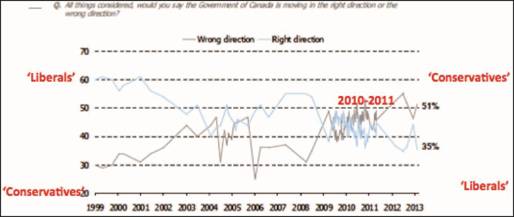
The key political motive of this minority Conservative government was to capture the hearts and minds of a mostly small-l liberal Canadian public. This was evident in the government’s polling on civil liberties and capital punishment,5 both key policy areas that divided liberals from conservatives, and which could tip the balance in order to gain a majority mandate in the next election. In Figure 3, the national polling firm (EKOS, 2013, February 16) demonstrates the shift of Canadians away from liberal views and voting for the Liberal Party to more conservative thinking and voting. It also shows clearly the volatile disposition of Canadians during the critical pre-election period in 2010-2011, as government communication and mediatization intensified.
While ramping up discourses of war, the Conservative government was also backing it materially through defence budgets that grew at a staggering rate during this time. The increases were part of a twenty-year strategy, the Canada First Defence Strategy, which started in 2008 to expand military personnel, equipment, infrastructure, and readiness. The total extra investment is $490 billion (Canada, 2013: ix). Other aspects of the government’s internal security focus—crime and immigration—also had increased budgets. This included $156 million for expansion of prisons, even though crime rates remained at their lowest ever recorded (CBC News, 2010, October 6). Specifically, at the key time prior to the 2011 election that gave the Conservatives their majority mandate, Canada was to spend more than $22.3 billion on the military, “about 18% more than it did at its peak year during the Cold War [1952-53] . . . and 26% higher than it was the year the Berlin Wall came down [1989-90]” (Robinson, 2011).6 It was also a 54% increase from 9/11 (CCPA, 2011).
Several examples demonstrate the government’s communication strategy that brought global or external security issues to the attention of the Canadian public and assisted in constructing a domestic need for strong responses on security-based issues. The government made this connection primarily through the promotion of Canadianness with defence and military issues, branding Canada in a much different way than we had always seen ourselves. The Afghan conflict provided an opportunity to ramp up these military discourses.
During the Afghan invasion, the Conservative government renamed the major highway between the military base where soldiers’ bodies arrive from Afghanistan and the military base where funeral services were to take place. It is now called the Highway of Heroes (see Figure 4). Stories appeared regularly in the media, especially on television, showing these scenes, as Canadians waved flags above the highway. The military hero thus became prominent in government discourses and photo ops, and these poignant visual scenes were taken up in media coverage. Each soldier’s death repeated and reinforced the message. One study in 2010 found that “[e]xposure to images of flag-draped coffins leads to greater support for the mission in Canada (Delacourt, 2014, September 27: A6).7
Figure 4: Highway of Heroes connects and reinforces a Link
between Militarism and Canadianness
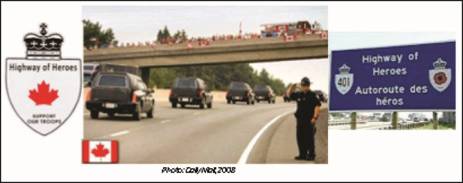
The government also brought attention to security issues by “being Canadian” and wearing red on Fridays (see Figure 5). The “wear red” campaign showed how citizens can be influenced by these seemingly citizen-led campaigns to support government initiatives. Yet, much of this was fostered in the United States, and then built through Conservative-friendly political blogs that easily crossed borders. The red in the Canadian flag then became linked to the idea of wearing red, which also connected to wearing red on Canada Day, a conflation of patriotism with “Canadianness.”
Figure 5: Former Defence Minister Peter Mackay wearing red on Red Friday
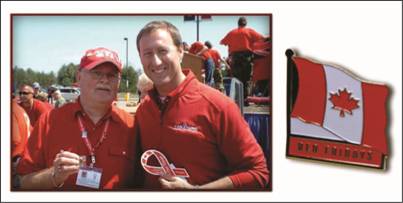
Along with visual cues, the government linked being Canadian to the Afghan “mission”—note the word “mission” instead of the more accurate “invasion”. The Canadian coffeehouse chain Tim Hortons was supposedly the favoured coffee of the military (see Figure 6). Importantly, the demographic that drank this company’s coffee was the same demographic as the Conservative Party: “ordinary”, “beige”, and “predictable” older Canadians who vote “in far higher proportions than younger people” (Delacourt, 2014, September 27: 2). The government received mileage in the media by allowing Tim Hortons to have an outlet on the base at Kandahar in Afghanistan, which reinforced the target audience for both the company and the party. The Tim Hortons connection also boosted the company’s profits, linking the government to business interests. While its net revenue in 2009/10 was less than the previous year, in each of 2010/2011 and 2011/2012, it climbed by 9.6% (Tim Hortons, n.d.). At one point, Former Defence Minister Peter MacKay used a Tim Hortons as a backdrop for a photo opportunity with a war veteran (see Figure 5). Tim Hortons heightened the connection by issuing their millions of coffee cups with the ribbon slogan “Support Our Troops” and its website address. These ribbons were and still remain on public transport and police cars across the country.
Figure 6: Prime Minister Harper drinking Tim Hortons Coffee
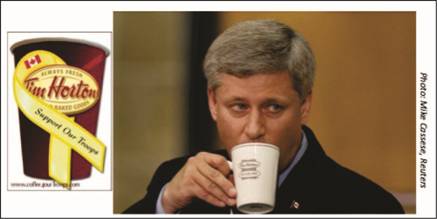
The government also stressed the rights of law-abiding Canadians in security messages. Another way to foster interest and awareness in these issues is to appear at symposia such as one hosted by the National Victims of Crime Awareness (see Figure 7). This organization was founded in the same year the Conservatives were elected. At the symposium, with an RCMP officer and a placard reading “Every Victim Matters”, Prime Minister Stephen Harper said “[w]e have always put the safety of law-abiding Canadians first. And we have always believed that every victim matters. So I call on Parliament to recognize that every victim matters, to get tough on crime and protect law-abiding citizens and to pass our vital law and order legislation” (Prime Minister’s Office, 2010: 1).7
Figure 7: Former Attorney General Rob Nicholson
and Prime Minister Stephen Harper
at the National Victims of Crime Awareness Meeting
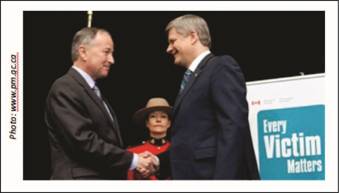
The government resurrected and commemorated The War of 1812, a war almost lost to history. In it, Canadians fought against the Americans and reinforced Canada’s relationship with England. On this ongoing commemoration, which is also being commemorated in the lead-up to Canada’s sesquicentennial, the Prime Minister Harper said, “[t]he War of 1812 was a seminal event in the making of our great country . . . Canadians have an opportunity to pay tribute to our founders, defining moments, and heroes who fought for Canada . . . The War was instrumental in creating Canada’s armed forces . . . It was the beginning of a long and proud military history in Canada” (Canada, 2012: 1). In so doing, the prime minister and his government were militarizing our history and constructing historic military heroes that never existed. Moreover, despite the rhetoric of founding a nation, Canada did not formally have its own armed forces until after World War I.
The government also reminded Canadians about the importance of security and—as with its connection to Tim Hortons—capitalist accumulation every time they made purchases by minting coins and paper money that illustrate themes reminiscent of security and the military. This included a silver coin to commemorate the Highway of Heroes, and a $20 bill featuring the Vimy Ridge memorial from World War 1, commemorating a strategic battle fought by Canadians in World War 1 (see Figure 8). Such images also appeared in the new Canadian passports, which then extends the branding internationally. As our finance minister said at the time the coin was released, “[w]ith this special coin, the Government of Canada is paying homage to everyday Canadians who have shown their unwavering support to the families who have accompanied our fallen soldiers as they made the journey along the Highway of Heroes” (Royal Canadian Mint, 2011: 1). Interestingly, the Tim Hortons coffee franchise became the exclusive distributor of another militarized coin that was embossed with a red poppy (Delacourt, 2014, September 27).
Figure 8: Former Bank of Canada Governor Mark Carney
and Former Finance Minister Jim Flaherty (middle photo)
at the launch of the $20 Vimy Ridge bill
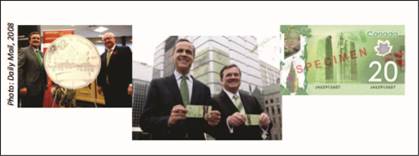
Not all these strategic communication efforts had the same impact. To the extent that it can be quantified, however, the “support our troops” efforts received media coverage and visible uptake by Canadians around the time of the 2006 election, but declined later. On the “Afghanistan mission”, the number of hits in a ProQuest search peaked in 2006, an election year, but slowly declined to the point that in the next election year (2011), the last Canadian combat troops were leaving Afghanistan and media interest and coverage was at its lowest. The Highway of Heroes had its highest coverage in 2010, but was strong throughout the 2008 to 2011 period.
However, the cumulative effect of many different strategic interventions on different levels, for different audiences and for different media platforms would have to be examined to fully understand what appears to be the holistic strategic communication planning of the Harper government, which is able to channel its communication messages through the public service (Kozolanka, 2014b), while also being the political party that for some years now has received a great many small donations from larger numbers of citizens that far outnumber those to other political parties (MacDermid, 2014), as well as a growing Prime Minister’s office and higher resources.8 Thus, it can use both the resources of the public service and party funds to extend its messaging.
While this research examines the factors that helped construct a majority mandate for the government in the 2011 election, it is also useful to be reminded that the use of military messaging has continued. One example is the sound and light show on Parliament Hill that has ditched its former text on human rights and indigenous peoples, and added the War of 1812, the 60th anniversary of the end of the Korean War, and the Highway of Heroes (Cook, 2013, July 10). As Canada moves towards it sesquicentennial, the government’s “Canada 150” website has been profiling the “Key Milestones on the Road to 2017”. The milestones are organized by each year since 2012 leading up to 2017. The government’s continued focus on militarism and war is very clear, with ten of the 22 featured milestones (or 45.5%) related to war and military themes (Canada 150, 2012). The slogan for the anniversary—”Strong. Proud. Free.”—is not only on the website, but is repeated in an ongoing series of advertisements now being broadcast across the country. It is difficult to distinguish this militarized and libertarian slogan as separate from the Conservatives’ own political campaign in the general election expected in 2015.
Constructing the Domestic Enemy
The Conservatives also used domestic policy issues opportunistically to construct an image of real Canadianness and an image of non-Canadianness or The Other. Here, the analysis of legislation—crime, immigration, and defence—will be used to demonstrate how the government linked these issues to domestic security and safety in government policy, legislation, and messaging, which then gets amplified by the media.
On crime, the government connected safety and security by emphasizing “the need for strong penalties and enacted legislation to ensure criminals are taken off the streets”, and emphasizing that “Canada will not be a safe haven for those who pose a threat to safety and security of Canadians” (Blanchfield, 2010, July 16: 1). On security and immigration, the government used a boatload of illegal refugees off the coast of Canada to stir up fear about our porous national borders that needed to be protected, accusing the refugees of endangering national security and having our refugee system “hijacked by criminals and terrorists” (Shelton, 2010, August 13: 1). On security and defence, the government has pursued the contentious purchase of fighter aircraft to, as it says, “meet the threats of the 21st century” (Blanchfield, 2010, July 16: 2). On this purchase, our prime minister also said that “now we will be able to see what the bad guys are up to” (Kennedy, 2010, August 26: A4).
In using these discourses that use security issues to construct an internal enemy in Canadian society, as fostered by both the government and to different degrees by mediatization in the mainstream media, another conception is taking root that has been constructed by the government of what makes a true Canadian and, by extension, who is not. The Public Safety minister at the time made this very clear when he spoke on legislation that curtailed pardons for criminals, saying, “[r]eal Canadians understand the consequences of not passing our pardons legislation” (Hansard, 2010, June 16: 3921).
To that end, in reviewing the discourses and messaging of the Conservative government, a clear choice was constructed and communicated to Canadians leading up to the 2011 election: either they sided with our domestic enemies—and these included violent criminals, refugee claimants who jump the queue and enter Canada illegally, those who are soft on terror and, generally, and anyone who disagreed with the government—or they were “real” Canadians: law-abiding, patriotic citizens, victims of crime, military personnel, and—apparently—everyone who agrees with the government. This profile echoed the Bush administration’s warning that “critics of the war on terrorism were riding with the terrorists” (Nacos et al., 2011: 124). As Nacos and colleageues (2011) also showed in their analysis of post-9/11 media coverage that elite and administrative sources dominated mainstream media coverage, here the mainstream media disseminated these messages relatively uncritically because of their link to security, while the Conservative blogging network continued to influence partisans.
Figure 9: In the 2011 election, Canadians choose Domestic Security
Source: Slide courtesy of EKOS. Note: Type in red added to slide by author.
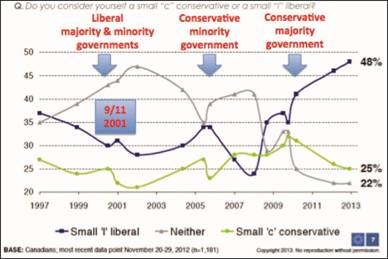
In summary, the “mission” in Afghanistan allowed the discursive war on terror to become concrete. The two needed and reinforced each other, and were mutually dependent. In the war on terror, just as with any war, we must be loyal citizens or we will be Othered as domestic enemies. The public environment changed as Canadians became “terrified” into becoming “Real Canadians” and supporting domestic security issues. Just as foreign policy became domestic policy, the global enemy became the domestic enemy. By forcing citizens into a “for” or “against” stance on its domestic security policy, the government was also priming Canadians to make a clear choice in the 2011 national election, ultimately realizing the goal of becoming a majority government. In so doing, the Conservatives used a classic Gramscian war of position that gathers force until it achieves initial dominance, here through electoral success (Kozolanka, 2007). As the polling results in Figure 9 illustrate, the 2010-2011 period was the Gramscian tipping point, showing considerable volatility as the Conservatives pressed forward with their legislative and communication strategies that demanded of citizens their patriotic loyalty, ultimately winning the majority government they sought.
Since then, the government has pushed on with and consolidated its legislative and communication efforts. At the time of this journal issue in early 2015, an election year, the government has introduced a new anti-terror bill (C-51) and a new crime bill that would keep the “most dangerous violent offenders” who commit the “most horrific crimes” in jail until they die (Loriggio, 2015, March 5: A8). Although recognized widely as a “political sleight of hand”, (Ibid) the government still marches forward—successfully—to its own militarized tune. |
References
Aiello, Rachel. (2015). “We ‘don’t have a clue’ what’s in omnibus bills, say MPs”. The Hill Times, pp. 1, 7.
Artz, Lee. (2011). The new rhetoric of the global war on terrorism. In Gerald Sussman (Ed.), The propaganda society: Promotional culture and politics in global context (pp. 213-228). New York: Peter Lang.
Blanchfield, Mike. (2010, July 16). Ottawa to spend $16 billion on fighter jets. The Toronto Star. Retrieved February 26, 2015, from http://www.theglobeandmail.com/news/politics/ottawa-to-spend-16-billion-
on-fighter-jets/article1389039/.
Brennan, Shannon. (2013). Police-reported crime statistics in Canada, 2011. Retrieved February 16, 2015 from, http://www.statcan.gc.ca/pub/85-002-x/2012001/
article/11692-eng.htm.
Canada 150. (2012). Canada 150. Strong. Proud. Free. Ottawa: Government of Canada Publications. Retrieved February 4, 2015, from http://canada150.gc.ca/eng/1342792785740.
Canada Border Services Agency. (2010, May 5). Public safety minister Toews commends removal of violent criminal from Canada. Retrieved September 3, 2010, from http://www.cbsa-asfc.gc.ca/media/prosecutions-poursuites/pra/2010-
05-06-eng.html.
Canada. (2012). Prime Minister’s message: The war of 1812—The fight for Canada. Retrieved May 20, 2013, from http://www.1812.gc.ca/eng/1305743548294/
1305743621243.
Canadian Civil Liberties Association. (2010). Bill C-10, the omnibus crime bill. Retrieved March 3, 2015, from http://www.cla.org/omnibus-crime-bill-c-10/.
CBC News. (2010, October 6). Tories announce $155.6 million prison expansion. Retrieved October 6, 2010, from http://www.cbc.ca/news/politics/tories-announce-
155-5m-prison-expansion-1.874590.
Cheadle, Bruce. (2103, May 9). Tories boast most private members’ bills. The Ottawa Citizen, p. A6.
Cook, Maria. (2013, July 10). Mosaika makes more of the military. The Ottawa Citizen, p. C1.
Cottle, Simon. (2009). Global crisis reporting: Journalism in the global age. Maidenhead, UK: Open University Press.
Delacourt, Susan. (2014, September 27). “Courting the Tim Hortons’ vote.” The Toronto Star, pp. 2-7. Retrieved April 8, 2014, from http://www.thestar.com/news/insight/2013/09/27/courting_the_tim_
hortons_voter.html.
EKOS. (2010, March 18). Canadians support decriminalization of minor pot possession and lean to not reintroducing death penalty. Retrieved May 22, 2013, from http://www.ekospolitics.com/wp-content/uploads/full_report_march_
181.pdf.
EKOS. (2010, June 8). “Public attitudes to police and oversight.” Presentation at CACOLE workshop.
EKOS. (2013, February 16). A newly competitive voter landscape. iPolitics. Retrieved May 22, 2013, from www.ekospolitics.com/articles/FG-2013-02-16.pdf.
EKOS. (2013, March 21). Left-right? Forward-backward? Examining longer term shifts in values, social class and societal outlook. Presentation to the School of Public Policy and Governance, University of Toronto.
Fox Piven, Frances. (2004). The war at home: The domestic costs of Bush’s militarism. New York: The New Press.
Freedman, Des & Thussu, Daya K. (Eds.). (2012). Media and terrorism: Global perspectives. London: Sage.
Hansard. (2010, June 16). House of Commons Debates. 3rd Session, 40th Parliament v. 145, n. 064.
Ipsos-Reid. (2010, January 25). Polls & research: U.S., Britain and Canada endorse death penalty.
Karim, Karim H. (2000). Islamic peril: Media and global violence. Montreal: Black Rose Books.
Kennedy, Mark. (2010, August 26). Harper salutes military for protecting the north. The Ottawa Citizen, p. A4.
Kozolanka, Kirsten. (2007). The power of persuasion: The politics of the new right in Ontario. Montreal: Black Rose Books.
Kozolanka, Kirsten. (2014a). Communicating for hegemony: The making of the publicity state in Canada. In Kirsten Kozolanka (Ed.), Publicity and the Canadian state: Critical communications perspectives (pp. 3-22). Toronto: University of Toronto Press.
Kozolanka, Kirsten. (2014b). In whose interest? Government communication and public accountability. In Kirsten Kozolanka (Ed.), Publicity and the Canadian state: Critical communications perspectives (pp. 49-69). Toronto: University of Toronto Press.
Lewis, Justin. (2012). Terrorism and news narratives. In Des Freedman and Daya K. Thussu (Eds.), Media and terrorism: Global perspectives (pp. 257-279). London: Sage.
Loriggio, Paola. (2015, March 5). Tory crime bill raises concerns. The Ottawa Citizen, p. A8.
MacDermid, Robert. (2014). Political funding regimes and political communication. In Kirsten Kozolanka (Ed.), Publicity and the Canadian state: Critical communications perspectives (pp. 151-171). Toronto: University of Toronto Press.
Massicotte, Louis. (2013, Spring). Omnibus bills in theory and practice. Canadian Parliamentary Review. Retrieved June 6, 2015, from http://www.revparl.ca/36/1/36n1_13e_Massicotte.pdf.
Mazepa, Patricia. (2011). Direct from the source: Canada’s integrated system of state propaganda. In Gerald Sussman (Ed.), The propaganda society: Promotional culture and politics in global context (pp. 297-313). New York: Peter Lang.
McCready, Andrea. (2010). Tie a yellow ribbon ‘round public discourse, national identity and the war: Neo-liberal militarization and the yellow ribbon campaign in Canada. Topia, 23-24, 28-51.
Miller, Mark C. (2005). Introduction. In Edward L. Bernays (Ed.), Propaganda (pp. 1-33). Brooklyn, NY: Ig Publishing.
Nacos, Brigitte L., Bloch-Elkon, Yaeli & Shapiro, Robert Y. (2011). Selling fear: Counterterrorism, the media, and public opinion. Chicago, IL: University of Chicago.
Prime Minister’s Office. (2010, April 19). PM launches fifth annual National Victims of Crime Awareness Week. Retrieved September 4, 2010, from http://www.pm.gc.ca/eng/media.asp?category=1&featureId=6&pageId=
3297.
Public Works and Government Services Canada. (2013). Canada first: Leveraging defence procurement through key Industrial capabilities. Retrieved June 26, 2014, from http://publications.gc.ca/site/eng/438378/publication.html.
Quan, Douglas. (2013, March 21). Tough-on-crime tories unapologetic. The Ottawa Citizen, p. A1.
Robinson, Bill. (2011). Canadian military spending 2010-11. Canadian Centre for Policy Alternatives. Retrieved September 29, 2011, from https://www.policyalternatives.ca/sites/default/files/uploads/
publications/National%20Office/2011/03/Canadian%20Military%20
Spending%202010.pdf.
Royal Canadian Mint. (2011). Royal Canadian Mint unveils Highway of Heroes silver commemorative coin. Retrieved February 25, 2015, from http://www.mint.ca/store/news/royal-canadian-mint-unveils-highway-of-
heroes-silver-commemorative-coin-13100005?cat=News%20releases.
Schiller, Dan. (2004). Communications and the crisis: From neoliberal to authoritarian development? In Pradip Thomas and Zaharom Nain (Eds.), Who owns the media? Global trends and local resistance (pp. 159-178). London: Zed Books.
Schiller, Herbert. (1992) Mass communication and American empire. Boulder, CO: Westview.
Shelton, Ian. (2010, August 13). Toews vows human-smugglers on migrant ships will be prosecuted. The Victoria Times-Colonist, pp. 1-2.
Staples, Steven. (2008). Harper, the military, and wedge politics. In Teresa Healy (Ed.), The Harper record (pp. 243-253). Ottawa, Ontario: Canadian Centre for Policy Alternatives.
Statistics Canada. (2012). Canadian Centre for Justice Statistics, Uniform Crime Reporting Survey.
Sussman, Gerald. (Ed.). (2011). The propaganda society: Promotional culture and politics in global context. New York: Peter Lang. |
